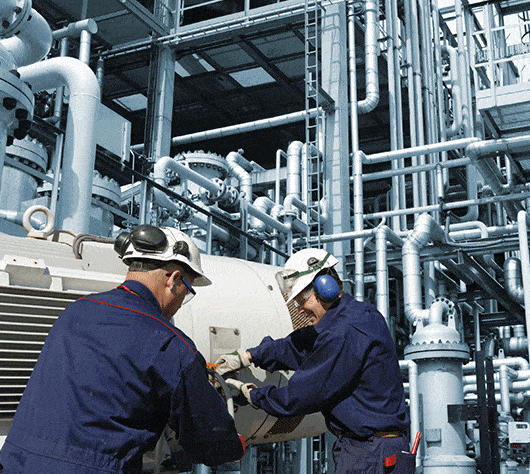3 Easy Facts About Roar Solutions Shown
3 Easy Facts About Roar Solutions Shown
Blog Article
Roar Solutions - The Facts
Table of ContentsThings about Roar SolutionsHow Roar Solutions can Save You Time, Stress, and Money.Roar Solutions Can Be Fun For Everyone
In order to safeguard installments from a possible surge an approach of analysing and categorizing a possibly hazardous area is required. The function of this is to ensure the correct choice and installation of devices to ultimately protect against an explosion and to ensure safety and security of life.
(https://profiles.delphiforums.com/n/pfx/profile.aspx?webtag=dfpprofile000&userId=1891249800)
No equipment must be mounted where the surface temperature level of the tools is greater than the ignition temperature of the provided threat. Below are some common dust harmful and their minimum ignition temperature. Coal Dust 380C 225C Polythene 420C (melts) Methyl Cellulose 420C 320C Starch 460C 435C Flour 490C 340C Sugar 490C 460C Grain Dust 510C 300C Phenolic Resin 530C > 450C Aluminium 590C > 450C PVC 700C > 450C Residue 810C 570C The chance of the risk existing in a concentration high adequate to trigger an ignition will differ from place to place.
In order to identify this risk a setup is split into locations of threat relying on the quantity of time the hazardous is present. These locations are described as Areas. For gases and vapours and dusts and fibres there are three areas. Zone 0 Zone 20 A harmful ambience is extremely likely to be present and may exist for lengthy periods of time (> 1000 hours per year) or perhaps continually Area 1 Zone 21 A harmful environment is possible however not likely to be present for lengthy periods of time (> 10 450 C [842 F] A classification of T6 implies the minimum ignition temperature is > 85 C [185 F] Harmful location electrical tools possibly made for usage in higher ambient temperature levels. This would indicated on the ranking plate e.g. EExe II C T3 Ta + 60C( This indicates at 60C ambient T3 will not be gone beyond) T1 T1, T2, T3, T4, T5, T6 T2 T2, T3, T4, T5, T6 T3 T3, T4, T5, T6 T4 T4, T5, T6 T5 T5, T6 T6 T6 A T Class ranking of T1 means the optimum surface temperature level generated by the tool at 40 C is 450 C. Assuming the connected T Class and Temperature level rating for the equipment are ideal for the location, you can always make use of an instrument with an extra stringent Department ranking than required for the location. There isn't a clear solution to this inquiry sadly. It truly does depend on the kind of devices and what repairs need to be lugged out. Equipment with details test treatments that can not be carried out in the area in order to achieve/maintain 3rd party ranking. Need to return to the manufacturing facility if it is prior to the tools's solution. Field Repair Service By Authorised Personnel: Complex screening might not be required nevertheless specific procedures might require to be adhered to in order for the equipment to maintain its 3rd event rating. Authorized personnel need to be used to execute the work properly Repair should be a like for like substitute. New element need to be taken into consideration as a direct replacement calling for no special testing of the equipment after the repair work is total. he has a good point Each tool with a dangerous ranking should be evaluated independently. These are described at a high level below, however for even more in-depth info, please refer straight to the standards.
Some Of Roar Solutions
The equipment register is a thorough data source of equipment documents that includes a minimum set of areas to identify each product's area, technological criteria, Ex lover classification, age, and environmental information. The proportion of Comprehensive to Shut examinations will certainly be established by the Tools Danger, which is analyzed based on ignition risk (the chance of a resource of ignition versus the chance of a flammable ambience )and the dangerous area classification
( Zone 0, 1, or 2). Executing a robust Risk-Based Examination( RBI )method is essential for making certain compliance and safety in taking care of Electric Equipment in Hazardous Areas( EEHA).
Excitement About Roar Solutions

In terms of eruptive danger, a harmful area is an environment in which an eruptive environment exists (or may be anticipated to be present) in quantities that call for special safety measures for the construction, installation and usage of devices. Roar Training Solutions. In this post we discover the obstacles encountered in the office, the threat control procedures, and the required competencies to function securely
It issues of modern life that we manufacture, keep or take care of a variety of gases or fluids that are regarded combustible, and a series of dirts that are deemed flammable. These materials can, in certain problems, form explosive ambiences and these can have major and awful consequences. The majority of us know with the fire triangle get rid of any among the 3 aspects and the fire can not happen, yet what does this mean in the context of dangerous locations? When breaking this down right into its simplest terms it is essentially: a combination of a particular amount of release or leak of a specific substance or material, mixing with ambient oxygen, and the presence of a source of ignition.
In most instances, we can do little regarding the levels of oxygen in the air, however we can have substantial impact on sources of ignition, as an example electrical equipment. Dangerous areas are documented on the harmful location classification illustration and are identified on-site by the triangular "EX" indicator. Below, amongst other key details, zones are split into 3 kinds relying on the threat, the chance and period that an eruptive environment will exist; Zone 0 or 20 is regarded one of the most harmful and Area 2 or 22 is considered the least.
Report this page